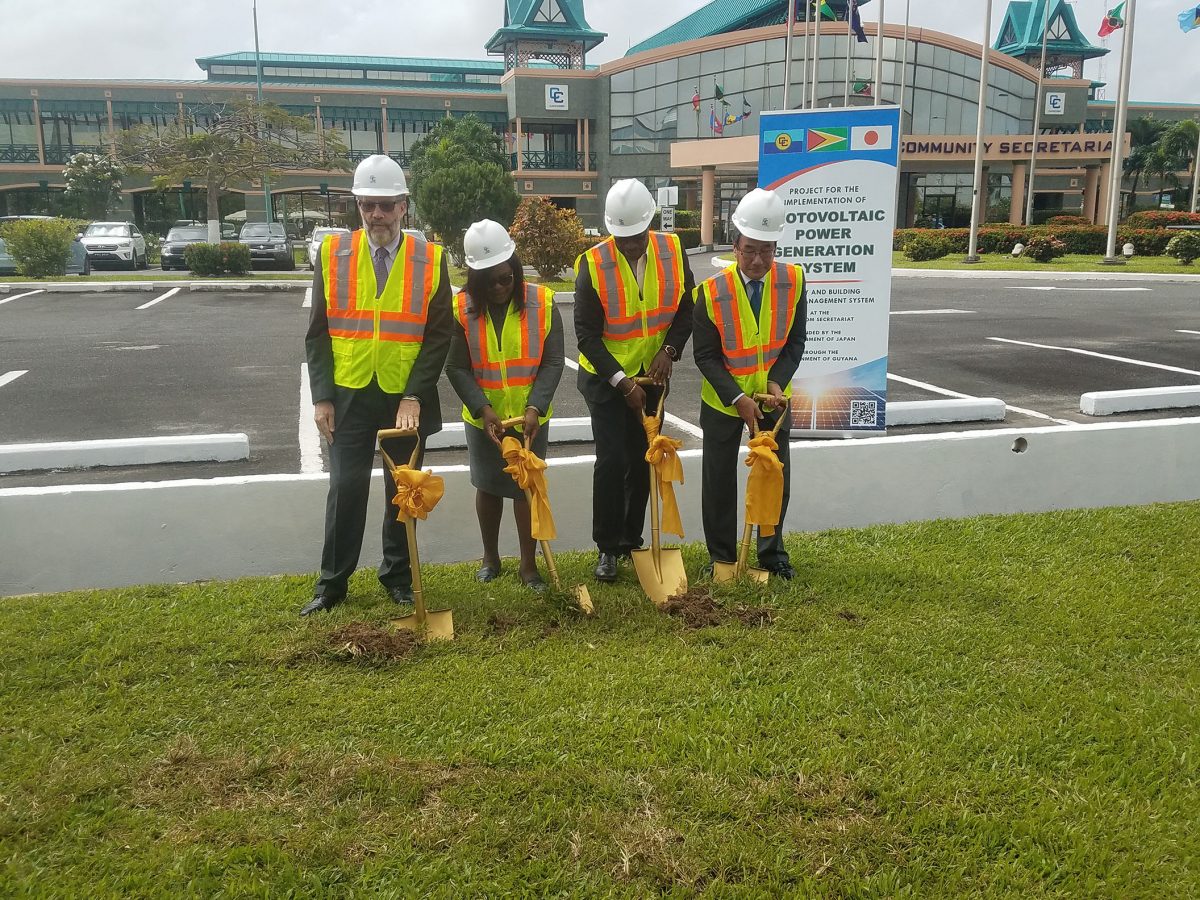By September of this year, the CARICOM Secretariat should be powered by solar energy thanks to US$18M in financing from Japan via the Government of Guyana.
The sod was yesterday turned at the Secretariat at Turkeyen signalling the launch of the Photovoltaic Power Generation System.
The project is expected to be completed in September and will move the CARICOM Secretariat towards 100 percent renewable energy. According to the Deputy Secretary-General and chair of the CARICOM Secretariat Energy Committee, Dr Manorma Soeknandan, the CARICOM energy policy which was adopted in 2013, articulates an ambitious vision to establish the region as a global example for the use of renewable energy. Soeknandan told the gathering at the ground-breaking ceremony, that during 2014, the Secretariat was faced with a severe financial crisis and it was that situation along with the approved policy that guided the energy vision for the Secretariat.
“Recognizing the linkage between policy and implementation, the Secretariat took the decision to demonstrate leadership through the effective management of the way in which we obtain and use energy to deliver our various services within the headquarters building”, she said.
The Deputy Secretary-General noted that it was in November 2014 and December 2015 that the secretariat approached the Government of Japan for financial assistance through the Japan International Cooperation Agency (JICA). She further stated that the secretariat in 2014 had expended US$500,000 in power, excluding the cost of fuel and other operating and maintenance costs.
“This situation was deemed unsustainable and was also a catalyst for the determination to improve the design of the energy system within the secretariat”, the chair of the Secretariat’s energy committee said. With JICA’s support the Secretariat was subsequently able to access grant-aid from Japan through the Government of Guyana.
“Utilizing 400 kilowatts of solar Photovoltaic power …together with battery energy storage and advanced building energy management systems, the Secretariat will not only be able to meet most, if not all of its electricity needs through a clean and secure source, but will also be able to export power to the grid, supplementing the existing GPL generation to the people of Guyana in the best of times”, Dr. Soeknandan stated. It was noted that the Secretariat is not only promoting its energy policy but is contributing to Guyana’s Green State Development Strategy (GSDS).
JICA, has been working on efficient energy use and renewable energy in Guyana in light of the policy set out by the Government of Guyana, said Tsutomi Kobayashi, the chief representative of JICA to the Caribbean. Kobayashi noted that it was in June 2018 when the Government of Guyana and JICA reached an agreement for the implementation of the project for the introduction of renewable energy and the improvement of power systems. He noted that in total just around US$18 million is being put into the project.
The Ambassador of Japan to Guyana and CARICOM, Tatsuo Hirayama, told the gathering that he was grateful to be a part of the historic occasion. He explained that Guyana and Japan have enjoyed a very strong history of cooperation and mutual support over the years. The ambassador, while congratulating Guyana on the successful launching of the production of petroleum, stated that it is encouraging to learn that even with the resources, the country is endeavouring to utilize renewable energy.
“I’m more than happy to be here at the CARICOM headquarters whose building we have partly contributed to funding and to break ground for a project to make the same building completely renewable energy oriented, this is another huge milestone in the partnership between Japan and CARICOM”, the ambassador said.
Delivering remarks on behalf of the Government of Guyana, Minister of Foreign Affairs, Dr. Karen Cummings stated “I’m of the view that it is a small but tangible demonstration of leading by example in the quest to diminish huge energy costs in the Caribbean in general and CARICOM in particular which is among the highest in the world, with its negative effects to our economy”.
She added that this project is concordant with CARICOM’s sustainable energy pathway and
consistent with Guyana’s trust towards a green economy.
“It is the intention of government to utilize some of the oil resources to enable the transformation of the Guyanese economy, to include a mix of renewable and more efficient energy sources in the near future”, Cummings noted.
According to the minister, through a component of the project, Guyana will benefit from the provision of power distribution materials and related equipment by the Government of Japan. She noted that it comes at an important juncture as the demand for reliable power is increasing and will continue to rise.
“This is the beginning of the end of a journey which began quite some time ago”, Secretary General of CARICOM, Irwin LaRocque commented. He noted that the initiative was fully supported by the executive management committee that urged that the headquarters should be a “Green building” as an example to other public buildings in the community. LaRocque lauded the support received over the years from the Government of Japan.
Subsequently, the Secretary General, Ministers of Foreign Affairs and Public Infrastructure and the Ambassador broke ground on the lawns of the CARICOM headquarters building for the project.





